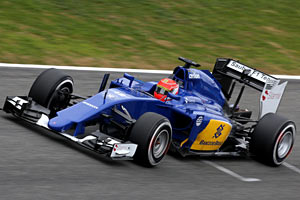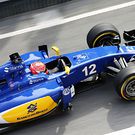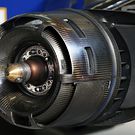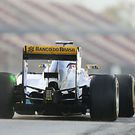Sauber C34 Ferrari

Active: 2015
Team: Sauber F1 Team
Team: Monisha Kaltenborn (TP), Eric Gandelin (CD), Willem Toet (HA), Elliot Dason-Barber (HVP), Beat Zehnder (TM), Giampaolo Dall'ara (HTE), Timothée Guerin (HTO), Reto Camenzind (CM)
Drivers: Marcus Ericsson (9), Felipe Nasr (12), Raffaele Marciello (Reserve)
During the development of the new Sauber C34-Ferrari the Sauber F1 Team’s engineers focused on three areas: performance in slow corners, weight reduction, as well as braking stability. The team's 2014 car had a notoriously poor balance while its reponse through low-speed corners was something of particular focus to improve for the C34.
The greatest visual difference compared to the Sauber C33 can be found around the nose section, which is bigger in volume and lower to the ground following further changes to the technical regulations. This has a considerable impact on the aerodynamics of the entire car: the nose and front wing play a key role in determining how the air flows around the front wheels and how effectively the central and rear sections of the car function aerodynamically. The new design of the wheel rims has progressed in a similar direction, in the interests of optimising airflow around the front wheels.
The front suspension concept changed little, with the springs and dampers again pushrod-actuated. However, the engineers put a lot of effort into improving the feedback from the steering for the drivers.
The sidepods of the new Sauber C34, however, are slimmer than those of the Sauber C33, despite higher cooling requirements from the upgraded Ferrari power unit. This has been made possible by modifications to the attachment of the side crash elements. In addition, the architecture of the radiators, which are now positioned horizontally, has been fundamentally revised.
Modified powertrain
The car’s engine, energy recovery system and gearbox are again supplied by Ferrari. The 1.6-litre turbocharged V6 engine has a rev limit of 15,000 rpm. The technical regulations allow for certain components to be completely redesigned for the 2015 season. The aim has been not only to increase the power from the turbocharged engine, but above all to optimise the car’s energy recovery and energy storage capability.
Changes to the engine's architecture have made numerous chassis adjustements necessary. Around the supplied package, in excess of 40 electronics boxes have had to be accommodated, of which more than 30 require cooling.
The exhaust tailpipe is again positioned centrally between two pylons, though they are no longer supported by the rear crash element, but by the gearbox housing.
The spring and damper elements at the rear axle are again pullrod-actuated, but otherwise this is a totally new construction with separate lower wishbone legs. In addition, the engineers worked on improving the mechanical traction.
At the time of its track debut at the first test at Jerez, the C34 was fitted with a base aerodynamic package, while internally some components were still from its predecessor.
The team introduced successive steps during winder testing to gradually test new components ahead of the season start at the Australian Grand Prix.
Sauber immediately set off to a strong double points finish at the season opening Grand Prix, following which things went downhill as other, more wealthy teams introduced upgrades to their cars.
Sauber did however introduce a considerable update package at the Singapore GP, an update that the team dubbed as crucial for the development direction of their 2016 car.
Specifications
Chassis: Carbon-fibre monocoque
Front suspension: Upper and lower wishbones, inboard springs and dampers actuated by push-rods
Rear suspension: Upper and lower wishbones, inboard springs and dampers actuated by pull-rods
Dampers: Sachs Race Engineering
Brakes: Brembo callipers and carbon fibre pads and discs
Transmission: Ferrari 8-speed quick-shift sequential carbon-cased gearbox, hydraulically activated. Longitudinally mounted
Clutch Carbon fibre plates
Electronics: FIA standard ECU and FIA homologated electronic and electrical system (as provided by MES)
Steering wheel: Sauber F1 Team
Tyres: Pirelli
Wheels: OZ, magnesium alloy
Dimensions
Length: 5,300 mm
Height: 950 mm (minus T camera)
Track width: 1,460 mm (front); 1,416 mm (rear)
Weight: 702kg (FIA mininum; incl. driver and lubricants, tank empty)
Powertrain
Designation: Ferrari 059/3
Type: turbocharged, 90° 1.6l V6, assisted with kinetic and heat ERS
Valves: 24 (4 per cylinder)
Rev limit: 15,000rpm
Pressure charging: Single turbocharger, unlimited boost pressure (typical maximum 3.5 bar abs due to fuel flow limit)
Bore: 80mm
Stroke: 53mm
Crank height: 90mm
Exhaust: Single exhaust outlet, from turbine on car centre line
Injection: Direct fuel injection, limited to 500bar
Weight: Undisclosed (at least 145kg)
Total horsepower: Approximately 600hp (ICE) + 160hp (ERS)
Energy recovery system: Integrated Hybrid energy recovery via electrical Motor Generator Units, by Ferrari
Energy Store: Lithium-Ion battery solution (up to 4MJ per lap), between 20 and 25 kg, by Ferrari



